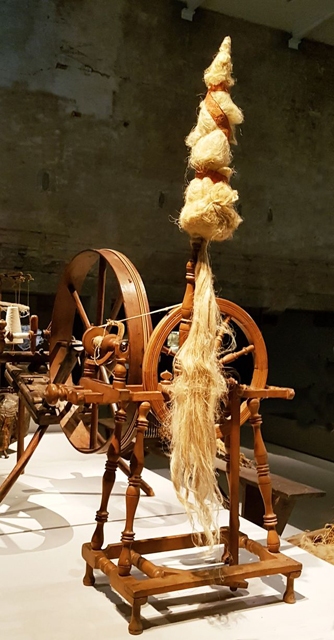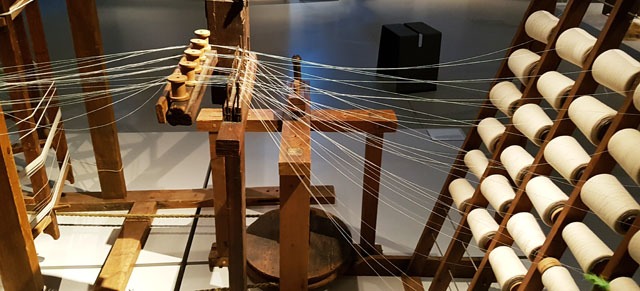What material do tablecloths have?
What material do tablecloths have? Tablecloths have to be robust and hard-wearing because they are often washed. The material from which the tablecloths are made should therefore be very resistant. Cotton is particularly suitable here, but linen and polyester have also become popular as tablecloth fabrics. In the following we have compiled various tablecloth materials and weaving specialities for you.
-
Cotton tablecloths
Most tablecloths today are made
 from cotton, a natural fibre that is obtained from the seed hair of cotton bushes. The fibres used for tablecloths are usually spun into thin threads and are highly absorbent. Cotton fabrics as a whole are skin-friendly and therefore extremely popular with allergy sufferers. Cotton fabrics and thus cotton tablecloths have numerous other positive properties, including high resistance to mechanical and chemical influences, high tensile strength, high wet strength and high abrasion resistance. In addition, cotton is easy to clean, can be washed very hot (heat resistant) and also has excellent dyeing properties. A yellowing occurs with dry cotton with approximately 160 degrees, only with approximately 250 degrees it becomes brown. Cotton tablecloths are appreciated mainly for their naturalness and pleasant fabric properties - unlike polyester tablecloths.
from cotton, a natural fibre that is obtained from the seed hair of cotton bushes. The fibres used for tablecloths are usually spun into thin threads and are highly absorbent. Cotton fabrics as a whole are skin-friendly and therefore extremely popular with allergy sufferers. Cotton fabrics and thus cotton tablecloths have numerous other positive properties, including high resistance to mechanical and chemical influences, high tensile strength, high wet strength and high abrasion resistance. In addition, cotton is easy to clean, can be washed very hot (heat resistant) and also has excellent dyeing properties. A yellowing occurs with dry cotton with approximately 160 degrees, only with approximately 250 degrees it becomes brown. Cotton tablecloths are appreciated mainly for their naturalness and pleasant fabric properties - unlike polyester tablecloths. -
Damask tablecloths
A damask tablecloth is considered the queen of tablecloths. In tablecloth vocabulary, damask refers to a woven fabric with a woven pattern. Damask tablecloths usually impress with a beautiful light reflection of the pattern. Damask patterns are not bound to special fibres/fabrics, but are mostly made from mercerised cotton, less often from silk or man-made fibres. In the Tablecloths-Shop Libusch you will only find damask tablecloths made of pure cotton or cotton-linen blends. The damask pattern in the fabric is created by alternating different atlas bindings. Most damask patterns can be found on plain fabrics and look very discreet. They are particularly visible with oblique incidence of light. Especially table linen with an elaborate damask pattern looks very noble and stylish. Among the most important patterns that have always adorned damask tablecloths are floral elements and motifs, especially flowers, blossoms and leaves, giving tablecloths a fresh, delicate and elegant elegance.
-
Linen tablecloths
Besides cotton, linen is one of the most popular tablecloth fabrics and has experienced a real boom in the textile sector in recent years. Flax or linen fibre is a bast fibre and is obtained from the stems of the flax plant. In contrast to cotton, linen fibres form so-
 called bundles which consist of unconnected individual fibres. Linen is mostly woven in the classic linen weave, but jacquard and other weave types are also common. The linen fibre is easily separable and finely spinnable, making it suitable not only for table linen but also for clothing. In addition, linen is lint-free and less susceptible to fabric tablecloths manufacturing dirt and bacteria, the fiber is bactericidal and antistatic due to its natural origin. Linen has a high tensile strength, is inelastic and therefore prone to creasing. However, the tear resistance makes the linen very hard-wearing and durable. Linen tablecloths can maintain their quality and texture unchanged for decades. It is not uncommon for (linen) tablecloths that still come from grandmother's linen closet to be so popular with young people. Linen tablecloths are astonishingly resistant to washing lyes, detergents and cooking laundry. If you do not appreciate the noble wrinkle effect of linen, you can iron and mangle linen tablecloths at high temperatures. The prerequisite for this is that the tissue is still moist. The tumble dryer, on the other hand, should not be used with linen tablecloths, as excessive and dry heat damages the fabric. You should also be careful when bleaching linen, full bleaching leads to a high weight loss! The dyeing of linen, on the other hand, is possible.
called bundles which consist of unconnected individual fibres. Linen is mostly woven in the classic linen weave, but jacquard and other weave types are also common. The linen fibre is easily separable and finely spinnable, making it suitable not only for table linen but also for clothing. In addition, linen is lint-free and less susceptible to fabric tablecloths manufacturing dirt and bacteria, the fiber is bactericidal and antistatic due to its natural origin. Linen has a high tensile strength, is inelastic and therefore prone to creasing. However, the tear resistance makes the linen very hard-wearing and durable. Linen tablecloths can maintain their quality and texture unchanged for decades. It is not uncommon for (linen) tablecloths that still come from grandmother's linen closet to be so popular with young people. Linen tablecloths are astonishingly resistant to washing lyes, detergents and cooking laundry. If you do not appreciate the noble wrinkle effect of linen, you can iron and mangle linen tablecloths at high temperatures. The prerequisite for this is that the tissue is still moist. The tumble dryer, on the other hand, should not be used with linen tablecloths, as excessive and dry heat damages the fabric. You should also be careful when bleaching linen, full bleaching leads to a high weight loss! The dyeing of linen, on the other hand, is possible. -
Tablecloths made of natural fibres
Because of the naturalness of the fabric in the truest sense of the word, tablecloths made of natural fibres are particularly popular. Natural fibres are vegetable or animal fibres that can be used to make tablecloths. Even in ancient times, plant fibres were mainly used for the production of home textiles and clothing, such as jute, linen, hemp, sisal or cotton. Animal fibres such as sheep's wool, angora (from the hair of the angora rabbit), silk (from the threads of the silkworm) or cashmere (from the hair of the cashmere goat) have also been known, loved and coveted as raw materials for textile production for thousands of years.
-
Modal tablecloths
Tablecloths made of Modal are rather rare. Modal refers to regenerated cellulose fibres which have similar properties to cotton. Modal fibers consist of 100 percent cellulose. The fibres can be woven very evenly and have a very high tensile strength, in addition they are only very slightly stretchable. Modal fibres are often mixed with cotton, sometimes for tablecloths. Modal is made from beech wood and is characterised by a silky sheen and excellent colour absorbency, which is particularly effective with piece-dyed goods, such as many tablecloths. Even after many washes, cotton-modal blended fabrics remain dimensionally stable and colourfast.
-
Tablecloths from Organza
Organza is a very transparent and dazzling fabric, mostly made of man-made fibres, rarely silk. Tablecloths made from organs are rare. The synthetic fibres of organza fabrics are interwoven with canvas. They crease quickly and are very sensitive to abrasion. Thread damage or thread shifts are immediately noticeable in organza fabrics. Organza fabrics are very light and fine, so they are particularly suitable for decorating, wrapping or covering. Organza fabrics are available in all conceivable colours.
-
Polyester tablecloths
Many tablecloths today are made of polyester, an artificial fabric.
 In the thirties/forties of the last century, the production of linear (unbranched) polyester fibres, so-called synthetic fibres, which have since been used in tablecloths, in tablecloths in general and in home textiles, was successful for the first time. In contrast to natural fibres, which originate from nature, polyester fibres are produced artificially, i. e. chemically. The threads drawn from the melt have high strength, are abrasion resistant and do not crease, making polyester tablecloths popular with many people. Since synthetic fibres absorb only little water during washing, polyester fabrics dry very well. Polyester (and also polyamide) fibres are much finer and thinner than silk, for example. One of the most important properties of the fabric is its special light and weather resistance and thus its resistance to climatic influences. Polyester fibres are very suitable for blends with natural fibres. It is not uncommon to find tablecloths and table linen made of a polyester-cotton mixture. Fabrics made of polyester fibres have a low tendency to crease and retain their shape even when exposed to moisture. They are easy-care, above-average hard-wearing. In 2007, more than 270,000 tons of polyester fibers were produced in Germany, and the trend is rising.
In the thirties/forties of the last century, the production of linear (unbranched) polyester fibres, so-called synthetic fibres, which have since been used in tablecloths, in tablecloths in general and in home textiles, was successful for the first time. In contrast to natural fibres, which originate from nature, polyester fibres are produced artificially, i. e. chemically. The threads drawn from the melt have high strength, are abrasion resistant and do not crease, making polyester tablecloths popular with many people. Since synthetic fibres absorb only little water during washing, polyester fabrics dry very well. Polyester (and also polyamide) fibres are much finer and thinner than silk, for example. One of the most important properties of the fabric is its special light and weather resistance and thus its resistance to climatic influences. Polyester fibres are very suitable for blends with natural fibres. It is not uncommon to find tablecloths and table linen made of a polyester-cotton mixture. Fabrics made of polyester fibres have a low tendency to crease and retain their shape even when exposed to moisture. They are easy-care, above-average hard-wearing. In 2007, more than 270,000 tons of polyester fibers were produced in Germany, and the trend is rising. -
Satin tablecloths
Tablecloths made of satin are very rare. Satin is a type of fabric that is produced using satin weave. The basis for this fabric is mainly silk or viscose fibres. Satin fabrics are characterised by a very shiny, smooth top side and a matt underside. Depending on the fiber type and yarn, satin can be light or heavy, matte or high gloss, flowing or stiff. Satin fabrics shine even brighter than silk. Tablecloths made of satin are rather rare to find.
-
Silk tablecloths
Silk is the name given to a fine textile fibre obtained from the cocoons of the silkworm. Originally silk probably came from China, today Japan, India and Brazil are other important producer countries. Silk is the only endless textile fibre found in nature. Among the most important species are reel silk, bourette silk, schappe silk, fagara silk and mulberry silk. The quality of the silk depends essentially on its weight. Silk is a beautifully shiny fabric of high strength, which also insulates against cold and heat. The silk can absorb water very well and tends to crease. Silk is particularly popular because silk fabrics achieve such brilliant colours. You have to watch out for high temperatures, abrasion and water stains. Therefore, silk tablecloths are rarely found.
-
Two-ply tablecloths
Two-ply tablecloths are especially indispensable in the gastronomy sector because of their durability. Two-ply yarn is a particularly hard-wearing cotton fabric for which two or more threads for warp and weft threads were twisted together before weaving. The yarn is therefore very strong and durable and ideal for tablecloths. The tablecloths, which are woven from full-thread cotton, have a high dimensional stability, are more durable and more long-lasting than conventional tablecloths. Full-thread tablecloths can withstand countless washing cycles, but are also more expensive to produce. Our tablecloths from the Padua series are made of two-ply cotton, as well are the white tablecloths from the Klara series made oft two-ply cotton.
